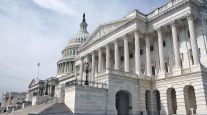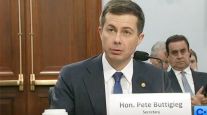Obama Unveils Transport Plan
This story appears in the March 3 print edition of Transport Topics.
WASHINGTON — President Obama said he will send a $302 billion, four-year transportation spending plan to Congress as part of his fiscal 2015 budget, telling a Minnesota audience that infrastructure work will provide jobs now and enable economic growth later.
Obama urged Congress to act, saying Feb. 26 in St. Paul that funding transportation infrastructure “is one of Congress’ major responsibilities.” He added that “roads and bridges should not be a partisan issue.”
A White House statement said part of the funding for the $302 billion plan will come from “$150 billion in one-time transition revenue from pro-growth business tax reform.” The White House has declined to endorse increasing federal taxes on diesel fuel and gasoline.
The president also said he would emphasize the Transportation Department’s TIGER grants, worth $600 million in this fiscal year.
Obama’s remarks came amid a deepening discussion of transportation issues in Washington. Sen. Barbara Boxer (D-Calif.) and Rep. Dave Camp (R-Mich.) addressed the issue last week while a House committee convened hearings on crafting a replacement for the current MAP-21 highway act that expires Sept. 30.
Camp, chairman of the House Ways and Means Committee, also unveiled a tax reform plan that would lower tax rates while broadening the tax base by eliminating deductions and credits. Camp’s plan includes an eight-year, $126.5 billion contribution to the Highway Trust Fund.
Transportation Secretary Anthony Foxx, who accompanied the president to St. Paul, has said the Highway Trust Fund could run out of money in August, even before MAP-21 expires.
Surface transportation funding dominated a meeting of the American Association of State Highway and Transportation Officials here, the same day as Obama’s speech.
Boxer, the chairman of the Senate’s Environment and Public Works Committee, told AASHTO members she had been briefed on the president’s transportation plan and called it “exciting and visionary,” but also said she doubts it will pass through both houses of Congress this year.
The senator said her committee will begin markup of a multiyear highway-funding plan in April, and the legislation probably will not include increases in fuel tax rates.
Boxer said she would like to see a five- or six-year plan completed by June because she does not want funding to “lurch from year to year.” She said she sees little to no support for diesel and gasoline tax increases among her colleagues. Funding for her spending plan will be constructed by Congress’ two tax-writing committees — the House Ways and Means and the Senate Finance Committee — not the Senate’s Environment and Public Works Committee, she said.
American Trucking Associations has supported increased transportation spending, with funding coming from higher motor fuel taxes. ATA has said the state of disrepair of roads and bridges has led to enormous levels of highway congestion. A recent statement from the group showed some change though.
“It is heartening that both President Obama and Chairman Camp recognize the critical need for revenue to finance infrastructure improvements,” ATA President Bill Graves said after Obama’s speech. “While a sustainable source of long-term funding would be preferable, given the apparent reluctance to embrace traditional, user-funded revenue streams, ATA is prepared to keep an open mind when looking at financing options for the Highway Trust Fund.”
AASHTO officers urged association members to lobby Congress on the importance of reauthorizing surface transportation. After hearing the president’s speech and reading some of Camp’s plan, Bud Wright, the group’s executive director said he was “encouraged.”
“The crisis facing the Highway Trust Fund and our national transportation infrastructure is very real. It is good news that the administration and congressional leadership in both houses are looking seriously at strategies to invest in transportation and maintain the solvency of the Highway Trust Fund and the programs it supports.”
Obama said he picked Union Depot in Minnesota’s capital because the passenger transportation hub is an example of the usefulness of TIGER — Transportation Investment Generating Economic Recovery — grants. The depot opened in 1926 and was renovated, in part with TIGER funds, in 2011 and 2012 to accommodate Amtrak, light rail and bus services.
Since its creation in 2009, TIGER has funded 270 projects spread across all 50 states and with a combined value of $3.5 billion.
Easing traffic congestion and fixing deteriorating infrastructure are critical to the freight industry, Henry Maier, CEO of FedEx Corp.’s FedEx Ground Package System Inc., testified at a hearing of the House Subcommittee on Highways and Transit on Feb. 27.
“Traffic congestion is not only a frustrating and inconvenient time drain, it is also inordinately expensive,” Maier told committee members exploring ways to improve the U.S. highway freight network.
To address traffic congestion, Maier said, allowing motor carriers to use 33-foot twins, rather than the current 28-foot trailers, could increase capacity for carriers such as FedEx by 18%.
Asked several times if FedEx would support user fees, Maier said the package carrier would support any user fees that are “reasonable and efficient.”
Susan Alt, senior vice president for public affairs for Volvo Group North America, also testified, saying efficient freight networks are essential for the truck manufacturer because supply chain deliveries can cause critical delays in getting a truck delivered on time.
When a truck is caught in a traffic jam and can’t make a delivery on time, there is a ripple effect that can damage the truck maker’s ability to stay competitive, Alt said.
“The Volvo Group believes that a full six-year, well-funded reauthorization is needed to address the persistent challenges,” Alt said.




